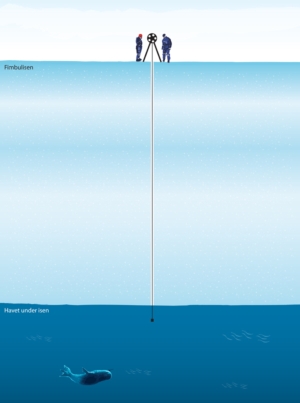Did you know that an ice shelf is a glacier floating on the sea?Nearly 10% of the “land” area of Antarctica is ice shelves. Researchers are currently studying one of the largest of these, Fimbulisen, to find answers to important questions about the Earth’s climate.

Antarctica has no rivers, but the continent still disgorges huge amounts of fresh water into the sea through melting from the underside of ice shelves. Fimbulisen in Dronning Maud Land is the ice shelf that contributes most fresh water to the sea. This water plays an important role in determining the distribution and thickness of the ice cover in sea areas adjacent to the ice shelf and for the creation of deep-sea water. ICE Fimbul Ice Shelf – top to bottom is a research project focused on climate in Antarctica. The aim of the project is to find out whether the warm water in the sea outside Fimbulisen penetrates in under the ice, speeding up ice melting – or not. The project examines mass balance, melting, and circulation in the seawater under the floating ice. These processes are important puzzle pieces if we want to understand enough to predict changes in global climate, and they have attracted much international attention. A multi-disciplinary team including oceanographers and glaciologists, and supported by skilled technicians, have paid several extended research visits to the ice shelf in recent years, and have amassed vital information on the climate. They have drilled through ice shelves as much as 1200 metres thick and deployed advanced measurement equipment. The scientists are currently analysing the data collected during the field work on Fimbulisen. The results so far indicate that the water that circulates in under the ice is not as warm as previously believed, but that turbulence outside the ice causes eddies of water to penetrate under the ice, and that this might lead to faster melting. No studies like those at Fimbulisen have ever been successfully done before, and now that the project is beginning to yield results, researchers may at last gain insight into how ice melts under the ice shelf in this crucially important part of Antarctica. The Norwegian Polar Institute heads the project ICE Fimbul Ice Shelf – from top to bottom and you can read more about the project on the web site. |
South Pole 1911–2011 is an informational outreach project run by the Norwegian Polar Institute
Contact person:


